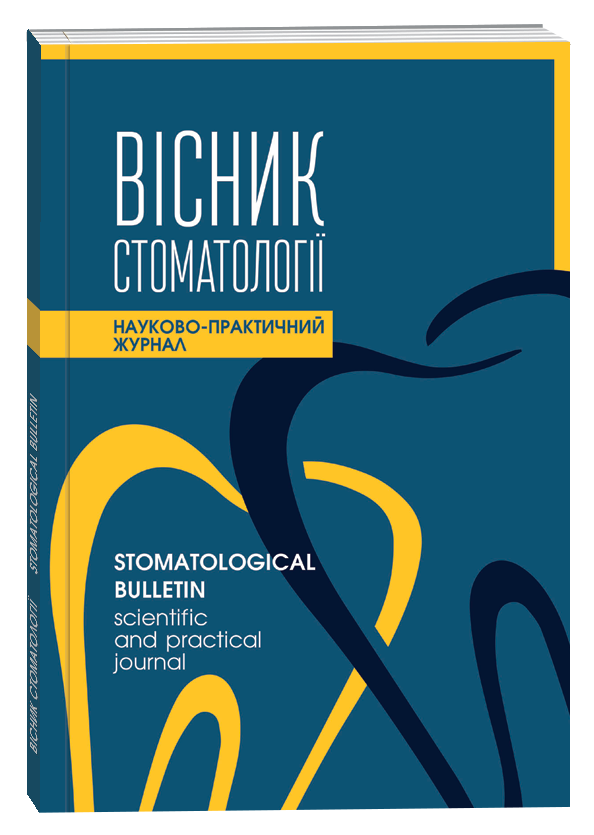COMPARISON OF APICAL AND CORONAL SEAL OF THE ROOT CANALS OF THE FIRST UPPER MOLARS WITH COLD LATERAL CONDENSATION TECHNIQUE AND THE USE OF TWO TYPES OF SEALERS IN VITRO
DOI:
https://doi.org/10.35220/2078-8916-2023-49-3.4Keywords:
upper first molars, apical sealing, crown sealing, endodontic treatmentAbstract
The aim of the research. To compare the quality of the apical seal of the root canals of the first upper molars with a differentiated and traditional approach to the treatment of the apical part of the root canal, with cold lateral condensation technique and the use of zinc-oxideeugenol sealer and sealer based on epoxy resins, as well as to determine the permeability of the root canals after obturation with additional sealing of their orifices with glass ionomer cement and without it. Research materials and methods. Extracted teeth, namely upper first molars without previous endodontic intervention, were used for the study. Endodontic preparation was carried out according to the proposed and traditional method, with the following filling of canals using zinc-oxide-eugenol sealer and sealer based on epoxy resins with a cold lateral condensation technique. In addition, in one of the groups, additional sealing of the orifices of the root canals was carried out using glass ionomer cement. The evaluation of sealing of the apical part of the canal was carried out on cross sections of the roots, which were made at a distance of 1 to 5 mm from the apex. After that, the area of the dyed surface was determined on the pictures using the ImageJ program. Sectoral determination of apical dye penetration was also carried out. To determine the depth of dye penetration in the orifice part, longitudinal sections were made on each of the first upper molar roots and digital images were taken, with further analysis in the ImageJ program. Scientific novelty. During the laboratory determination of the apical and coronal seal of the root canals of the first upper molars, it was found that when using the proposed method of processing root canals, the depth of apical dye penetration is significantly lower, compared to the traditional way. Also, the area of staining and % dye penetration is lower in this group. Conclusions. It has been established that sealing efficiency depends on the anatomical shape of the root canal and the method of its processing. It was found that with additional sealing of the orifice part of the root canals with glass-ionomer cement, the depth of dye penetration is significantly lower than in the absence of sealing.
References
Burns L.E., Kim J., Wu Y., Alzwaideh R., McGowan R., Sigurdsson A. Outcomes of primary root canal therapy: An updated systematic review of longitudinal clinical studies published between 2003 and 2020. Int Endodontic J. 2022. Vol.55. № 7. Р. 714-31.
Shin J., Lee D., Lee S. Comparison of antimicrobial activity of traditional and new developed root sealers against pathogens related root canal. Journal of Dental Sciences. 2018.Vol.13. № 1.P. 54-9.
Komabayashi T., Colmenar D., Cvach N., Bhat A., Primus, C., Imai Y. Comprehensive review of current endodontic sealers. Dental materials journal. 2020. Vol.39. № 5 P.703-720 doi:10.4012/dmj.2019-288.
Bansode Dr., Pradnya V. et al. Obturating Materials Present and Past: A Review. Journal of Dental and Medical Sciences. 2018. Vol.17. № 3 PP 27-33 www.iosrjournals.org.
Bodanezi A., Munhoz E. A., Capelozza A. L., Bernardineli N., Moraes I. G., Garcia R. B. Influence of root canal sealer on the radiographic appearance of filling voids in maxillary single-rooted teeth. Journal of applied oral science:revista FOB. 2012 Vol.20 № 4 404–409 https://doi.org/10.1590/s1678-77572012000400003.
Vula V., Stavileci M., Ajeti N., Vula V., Kuçi A., Meqa K. Evaluation of Apical Leakage After Root Canal Obturation with Glass Ionomer, Resin, and Zinc Oxide Eugenol Sealers Combined with Thermafil. Medical science monitor basic research. 2022 Vol.28, https://doi.org/10.12659/MSMBR.936675.
Kobryn N., Hereliuk V. Components of the Effectiveness of Endodontic Treatment Based on Longterm X-ray Criteria. Archive of Clinical Medicine. 2022 Vol 28. P. 29-33.
De Angelis F., Buonviver M., Argentino R., Vadini M. In Vitro Microleakage Evaluation of Bioceramic and Zinc-Eugenol Sealers with Two Obturation Techniques. Coatings. 2021. Vol. 11. № 6. P. 727.
Shetty K.P., Satish S.V., Luke A.M., Badade A.R., Kilaru K.R. In vitro interrelationship between apical fill and apical leakage using three different obturation techniques. J Int Soc Prevent Communit Dent. 2018. Vol.8. P.503- doi: 10.4103/jispcd.JISPCD_436_17.
D'Costa Vivian, Bangera Madhu. Coronal Seal in Endodontics. International Journal of Current Research. 2017. Vol.9. P.49499-49502.
Humel Maria, Oliveira Marcelo, Cavalli Vanessa, Giannini Marcelo. Effect of storage and disinfection methods of extracted bovine teeth on Bond strength to dentin. Brazilian Journal of Oral Sciences. 2006. Vol 6. № 22.
Kersten H. W.,Tencate J. M., Exterkate R. A., Moorer W. R.,Thoden Van Velzen S. K. A standardized leakage test with curved root canals in artificial dentine. International endodontic journal. 1998. Vol.21. № 3. Р.191–199. https://doi.org/10.1111/j.1365-2591.1988. tb00974.x
Чайковський І.Г. Експериментальне обґрунтування вибору методу тривимірної обтурації кореневих каналів в залежності від методу активації іригаційного розчину на етапі очистки і дезінфекції. Вісник стоматології. 2015. № 1. С. 51–55.
Poslavskaya O. V. Determination of linear dimensions and square surfaces areas of morphological objects on micrographs using ImageJ software. In Morphologia. 2016. Vol. 10. Issue 3. P. 377–381.
Barthel C. R., Lösche G. M., Zimmer S., Roulet J. F. Dye penetration in root canals filled with AH26 in different consistencies. Journal of endodontics, 1994. Vol.20 № 9. Р. 436–439 https://doi.org/10.1016/S0099-2399(06)80033-6.
Radeva Elk, Usunov Ivanov. Apical microleakage of four materials after root end resection (in vitro study). Acta Medica Bulgarica. 2016.Vol. XLIII. P. 61-67









